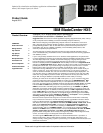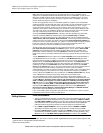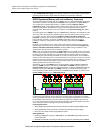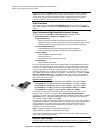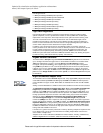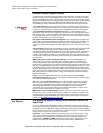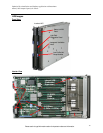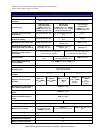
Optimized for virtualization and database applications with maximum
memory and compute capacity in a blade
Please see the Legal Information section for important notices and information.
3.
• Embedded virtualization (optional on all models) offers extremely high performance, enhanced
security, and a zero-gigabyte HDD footprint. (In other words, no mechanical HDD to fail.)
• Solid state drives (SDDs) use only 2W of energy per drive, vs. 9-10W for 2.5-inch HDDs. This is as
much as 80% less energy than a HDD would use (with a corresponding reduction in heat output).
• The extremely high degree of integration in the various BladeCenter chassis reduces the need for
server components, replacing numerous fans, KVM and Ethernet cables, power supplies, external
switches and other components with fewer shared hot-swap/redundant components in the
BladeCenter chassis itself. This integration also can greatly reduce the amount of power
consumed and heat produced, relative to an equivalent number of 1U servers. This can
significantly reduce a data center power bill. The reduced data center footprint can also save on
infrastructure cost.
• The midplanes used in all chassis provide high-speed blade-to-blade, blade-to-switch-module
and module-to-module communications internally as well as externally. The midplanes used in
the BladeCenter H and BladeCenter HT chassis provide four 10Gb data channels to each blade,
and supports high-speed switch modules, including 4X InfiniBand and 10Gb Ethernet.
• The various BladeCenter chassis use ultrahigh efficiency power supplies. Most industry-standard
servers use power supplies that are between 70-75% efficient at converting power from AC wall
current to the DC power used inside servers. BladeCenter power modules are up to 92% efficient.
This helps save even more money, as more of the power input you are paying for is used for
processing, rather than released into the data center as waste heat that requires even more energy
to cool.
• BladeCenter design also reduces the number of parts required to run the system. Sharing fans,
systems management, and optical media means fewer parts to buy and maintain, and fewer items
that can fail and bring the overall solution down.
Flexibility
The HX5 has the ability to grow with your application requirements, thanks to:
• Up to two multi-core Xeon processors (up to 16 cores) per HX5 blade server; up to 2 blades (4
processors, 32 cores) per server.
• The ability to grow from a single-wide 2-socket server blade to a double-wide 4-socket server
configuration, optimized for compute-intensive workloads with up to 4 processors/32 cores,
256GB of memory, 4 PCIe cards, 16 I/O ports, and 4 SSDs), or for memory-intensive workloads
with up to 2 server blades and two MAX5 memory expansion blades (4 processors/32 cores, 640GB
of memory, 4 PCIe cards, 16 I/O ports, and 4 SSDs).
• A choice of processor speeds (1.86 or 2.0GHz), and shared L3 cache sizes (12MB, 18MB, or
24MB).
• Up to 128GB of system memory in 16 DIMM slots. Using multiple blade servers and MAX5 memory
expansion blades, the HX5 can support up to 256GB (2 server blades), 320GB (1 HX5 and 1
MAX5), or 640GB (2 HX5 servers and 2 MAX5 blades).
• Up to two internal hot-swap 1.8-inch solid state drives, and access to terabytes of external storage
via the BladeCenter S chassis or IBM System Storage
™
SAN and NAS storage devices. SSDs
consume only 10-20% of the energy required by 2.5-inch HDDs.
• Two Gigabit Ethernet ports standard, plus optional 2-port or 4-port expansion cards or a
BladeCenter PCI Express I/O Expansion Unit 3. One HX5 model includes a 10Gb expansion card
(optional in the other models).
In addition, the various BladeCenter chassis offer a high degree of flexibility:
• They support configurations that are 30mm or 60mm wide, with a variety of I/O options, depending
on need.
• When installed in a BladeCenter H high-speed switch bay, the optional Multi-Switch Interconnect
Module doubles the number of Gigabit Ethernet and Fibre Channel connections to every blade in
the chassis (up to 8 or 12 ports, depending on the blade server).
• Xeon processor-based HX5 blades can be used in the same chassis as Intel processor-based
HC10, HS12, HS20, HS21, HS21 XM, HS22, HS22V, and HS40 blades; AMD Opteron processor-
based LS20, LS21, LS22, LS41 and LS42 blades; IBM PowerPC
®
processor-based JS20, JS21,
and JS22 blades; POWER6
®
processor-based JS12, JS23, and JS43 Express blades; POWER7
®
processor-based PS700, PS701, and PS702 blades; Cell Broadband Engine™ processor-based
QS21; and IBM PowerXCell™ processor-based QS22 blades. Depending on the blade servers
used, the various BladeCenter chassis support Microsoft Windows, Linux, Novell Netware, IBM
AIX
®
and Sun Solaris 10 operating systems in the same chassis.



